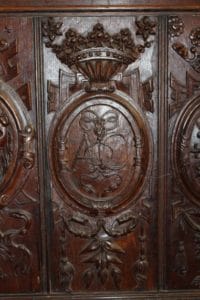 Sarah Morris, co-author of In the Footsteps of Anne Boleyn and In the Footsteps of the Six Wives of Henry VIII, and owner of The Tudor Travel Guide Facebook page emailed me with this update on the Anne of Cleves heraldic panels which she helped to identify back in 2015. It’s worrying news, but there’s a way we can all help.
Sarah Morris, co-author of In the Footsteps of Anne Boleyn and In the Footsteps of the Six Wives of Henry VIII, and owner of The Tudor Travel Guide Facebook page emailed me with this update on the Anne of Cleves heraldic panels which she helped to identify back in 2015. It’s worrying news, but there’s a way we can all help.
Sarah is going to give us all more information in a mini-documentary on the panels which she is releasing on YouTube tomorrow (28th December) at 8pm UK time. You will be able to view it at https://www.youtube.com/watch?v=IMz6DI7MMDo&feature=youtu.be.
But here is a bit more information from Sarah:
“It’s Sarah from The Tudor Travel Guide here. Back in 2015, I was lucky to be part fo the small team, which included Jonathan Foyle and Christine Hill, that ‘discovered’ the Anne of Cleves Heraldic Panels; a set of 22 finely carved, oak panels bearing the initials and emblems of Anne of Cleves.
They made up a new ‘nationally important historic collection’, a rare find of a personal, domestic interior associated with Tudor royalty.
The panels had been misidentified over the years, but through bringing modern techniques and know-how to bear, we were able to establish that they were without doubt contemporary to Anne of Cleve’s lifetime.
They bore her personal emblems and undoubtedly must have decorated a very high status chamber, likely in one of her dower properties; perhaps Bletchingley, or the King’s Manor at Dartford.
Last year it became clear that the fabric of the church was crumbling – badly. There is serious water penetration in parts of the church, and just in the last couple of months one of the parapets fell off. Luckily, no-one was hurt.
I am passionate about Tudor history; for me buildings and artefacts form a physical connection to some of my historical heroines & heros – Anne of Cleves being one of them. She was a woman I came to greatly admire through my research for ‘In the Footsteps of the Six Wives of Henry VIII’.
I don’t know about you, but for me, artefacts like these allow me to connect more deeply with the person who had them created. These panels meant something to Anne. They reminded her of her heritage and homeland (somewhere she missed greatly in the latter years of her life). Through these I can understand her just that little bit better.
This collection of panels are unique. There are few royal, Tudor interiors of this kind in existence…and as you can hear about in the accompanying video (release date 28th December at 8pm), the strap-work carved into the panels represents some of the earliest known in England. Anne of Cleves was trend-setting!
I wanted to step in and help the church council who have a whopping bill of £750,000 to pay to make good the building. The work, however, is being split into phases and the most urgent work, to protect the principal treasures, will cost some £90,000.
I couldn’t stand by and do nothing. I know that we care about Tudor history with a passion and that the preservation of historic buildings and Tudor artefacts matter to people like us.
So, my role in this is to help spread the word of the damage being done – and the threat to the panels. If you want to act, the church council have set up a Just Giving page, where you can donate whatever you are able to afford.
Please also share this page with at least one other friend. In that way we can keep the conversation going until the panels are safe again. Thank you for giving your support.”
Donate via the St Leonard’s ‘Just Giving Page’ (Note: this page is not managed, or affiliated, in any way by The Tudor Travel Guide)
https://www.justgiving.com/stleonards-oldwarden?
Like the ‘Save the Anne of Cleves Heraldic Panels’ Facebook Page and share with least one friend to help spread the word at:
https://www.facebook.com/savetheanneofclevesheraldicpanels/
Here’s the video, although you won’t be able to watch it until it goes live on 28th December:
Photo: Taken from The Tudor Travel Guide Blog by Sarah Morris.